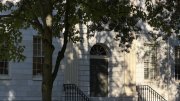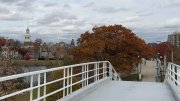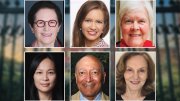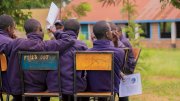Harvard leadership is committed to making academics the focus of the student experience, Dean Hopi Hoekstra said at a meeting of the Faculty of Arts and Sciences (FAS) this week.
“The classroom must remain the center of gravity for our students,” Hoekstra told the faculty assembled in University Hall on October 7 for the first FAS meeting of the school year. “It is where Harvard’s promise is realized.”
Hoekstra noted the challenges outlined in a report released last winter by the Classroom Social Compact Committee, which suggested that classwork is a lower priority than extracurriculars and other pursuits for many students, that grade inflation is widespread, and that some students and faculty feel uncomfortable sharing their views and opinions in classroom discussions—whether for fear of looking uninformed or out of concern about political backlash.
Changes are already underway: this summer, incoming first-year students took an online orientation course that focused on academics. And thanks to an FAS vote last spring, class discussions are now subject to the Chatham House Rule: outside the classroom, participants may share the contents of a discussion, but not the identity of the speakers.
Among the other tasks ahead is making it easier for students to fit the classes they want into their schedules. In a recent study of the instructional day—prompted by a mandatory review of changes approved in 2017—staff members found that an average of 58 percent of FAS lecture courses are taught between the peak hours of 10 a.m. and 2 p.m. Few courses are scheduled in the 9 a.m. time block or on Fridays.
In addition to the logjam of classes, faculty were told, course offerings in Allston are limited and often overlap with class-time blocks in Cambridge. And in general, students don’t have enough time for lunch.
FAS staff did find identify some improvements to the class schedule since the 2017 vote, such as an increase in flexible scheduling blocks and the successful elimination of “Harvard time,” the long-accepted practice of allowing students to show up for classes up to seven minutes late. (That last example drew chuckles from a few faculty members in attendance.)
Hoekstra emphasized that changing the academic experience will require collective action among the faculty.
“It’s about making what happens in the classroom something that they don’t want to miss out on,” she said. “We have an opportunity to reestablish the classroom as a place of wonder and challenge.”
Also at the meeting, Hoekstra referenced Harvard’s current financial challenges and noted the work of three committees announced in the spring: workforce planning, research continuity, and resources. She said the University is studying new ways to tackle financial headwinds caused by government actions and has provided support for faculty research when federal grant funding decreased.
“We are meeting this moment with clear purpose and steady action,” she said.
She also cited an unlikely patron of Harvard science: a six-year-old girl from Springfield, Massachusetts, named Marianne who was fascinated by associate professor of stem cell and regenerative biology Jessica Whited’s research on axolotl salamanders and enlisted family and friends to raise $1,000 for Whited’s lab.
While last year’s faculty meetings often featured impassioned discussions about the turmoil on campus, the October 7 faculty meeting was a quieter affair, though a few professors raised familiar concerns. One noted some administrative actions in recent months, such as the dismissal of leaders in the Center for Middle Eastern Studies and the removal of Black Lives Matter signs across the windows of the Northwest Science Building, and declared that many faculty are afraid to speak their minds because they fear the University won’t support them if they’re attacked.
Hoekstra noted the academic freedom protections in the faculty and student handbooks and pointed to resources for faculty who face harassment online or in the physical world, including individualized help through the Office of Faculty Affairs.









